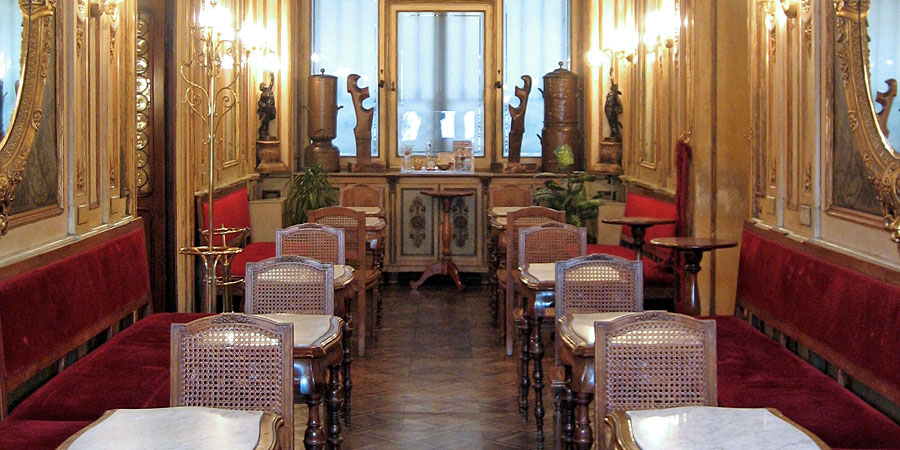Caffè Florian was opened in 1720 in the Procuratie Nuove of Piazza San Marco in Venice. Caffè Florian is Italy’s oldest Café. While seated in one of the café’s frescoed rooms or outside listening to the orchestra in the Piazza, one can enjoy impeccable service and products of the finest quality.
Famous for its rich history as a crossroads of art, culture, politics and entertainment, today the Florian is also known for its elegant trademark products: coffee, teas, chocolates, cookies, porcelains, and design objects.
History
Coffee, which the Venetians first recorded in Turkey in 1585, began to be sold commercially in Venice in 1638, and coffee houses soon sprang up around the city. The Florian opened with two simply furnished rooms on 29 December 1720 as Caffè alla Venezia trionfante (the Café of the Triumphant Venice), but soon became known as Caffè Florian, after its original owner Floriano Francesconi. The elegant surroundings attracted many of the notables of the day including the playwright Carlo Goldoni, Goethe and Casanova, who was no doubt attracted by the fact that Caffè Florian was the only coffee house that allowed women, and later Lord Byron, Marcel Proust, and Charles Dickens were frequent visitors. It was one of the few places where Gasparo Gozzi's early newspaper Gazzetta Veneta could be bought, and became a meeting place for people from different social classes. In the mid-18th century the Florian expanded to four rooms.
Valentino Francesconi, the grandson of Floriano Francesconi, took over the business at the beginning of the 19th century, and passed it on to his son Antonio, but by 1858, the establishment had passed into the hands of Vincenzo Porta, Giovanni Pardelli, and Pietro Baccanello and was in need of some restoration. Lodovico Cadorin was commissioned to carry out restoration work and redecorate the interiors, but there was public outcry over the expense and because he was tampering with a much loved institution. However the work pressed on, and the interiors of the rooms were redecorated in opulent splendour and rebaptised with the names by which they are still known today. The Sala degli Uomini Illustri (Hall of the Illustrious Men) featured paintings by Giulio Carlini of ten notable Venetians: Goldoni, Marco Polo, Titian, Francesco Morosini, Pietro Orseolo, Andrea Palladio, Benedetto Marcello, Paolo Sarpi, Vettor Pisani and Enrico Dandolo. In the Sala del Senato (Senate Hall) the walls are decorated with panels depicting scenes from the worlds of the arts and sciences by Casa with the theme Progress and Civilisation instructing the Nations. The Sala Cinese (Chinese Hall) and Sala Orientale (Oriental Hall) take their inspiration from the Far East with paintings of lovers and scantily clad exotic women painted by Pascuti. The Sala delle Stagioni (Hall of the Seasons) or Sale degli Specchi (Hall of Mirrors) was decorated by Rota with the figures of women representing the four seasons. The Sala Liberty which was added at the beginning of the 20th century is decorated with hand-painted mirrors and sumptuous wooden wainscotting.
Art
From 1893, at the prompting of Ricardo Selvatico who had been inspired while dining in the Senate Hall, the Florian became home to the Esposizione Internazionale d'Arte Contemporanea (International Exhibition of Contemporary Art), an ever-changing display of work from the artists of the time, known today as the Venice Biennale. The rooms of the Florian have been decorated with the works of artists, sculptors, photographers and cartoonists. In 2003, Irene Andessner added Le Donne Illustri (The Illustrious Women), ten portraits of notable women of Venice, to the Hall of the Illustrious Men. Many of the works of art are part of the Florian's private collection and are loaned to art museums around the world. Music also features at the Florian from April to October.


